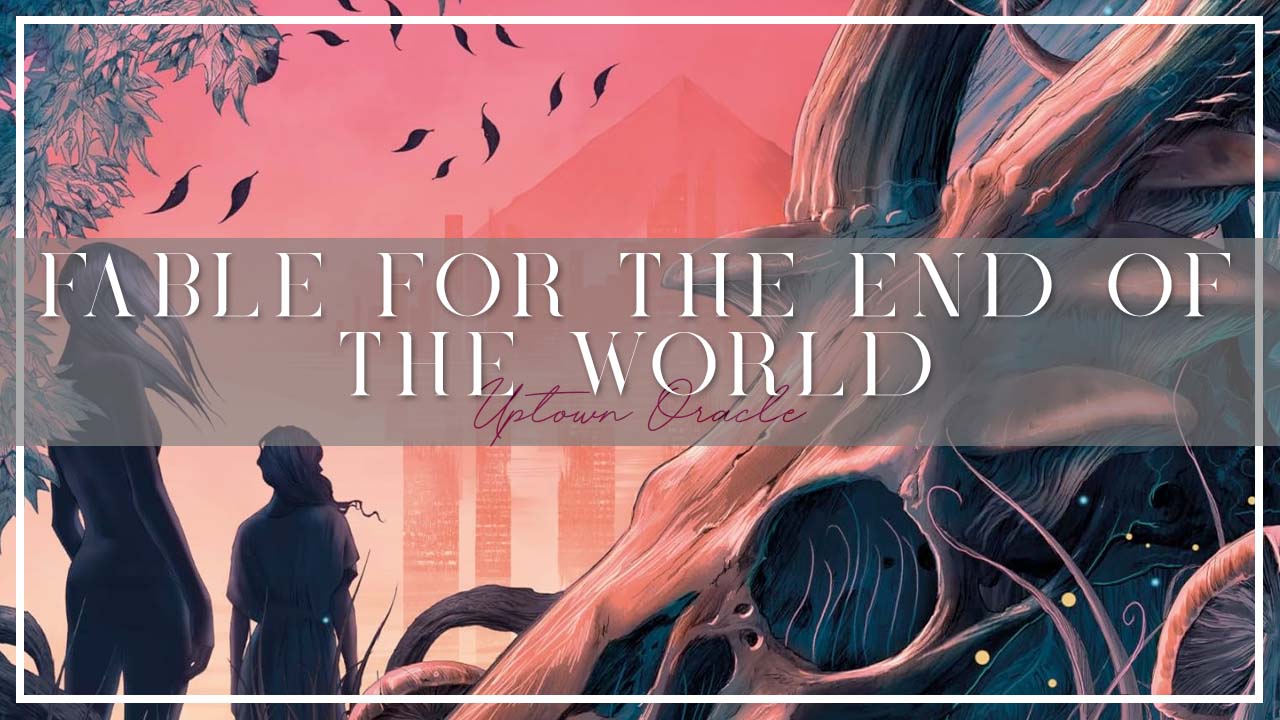Fable for the End of the World by Ava Reid is a tense, dystopian fantasy that brings together survival, corporate control, and complex human relationships in a world buckling under climate and economic collapse. With dual points of view, enemies-to-lovers romance, and a sharp commentary on power and isolation, this novel offers an emotionally charged reading experience for fans of dystopian fantasy and LGBTQ+ narratives.




(Affiliate Links)
By encouraging massive accumulations of debt from its underclass, a single corporation, Caerus, controls all aspects of society.
Inesa lives with her brother in a half-sunken town where they scrape by running a taxidermy shop. Unbeknownst to Inesa, their cruel and indolent mother has accrued an enormous debt—enough to qualify one of her children for Caerus’s livestreamed assassination spectacle: the Lamb’s Gauntlet.
Melinoë is a Caerus assassin, trained to track and kill the sacrificial Lambs. The product of neural reconditioning and physiological alteration, she is a living weapon, known for her cold brutality and deadly beauty. She has never failed to assassinate one of her marks.
When Inesa learns that her mother has offered her as a sacrifice, at first she despairs—the Gauntlet is always a bloodbath for the impoverished debtors. But she’s had years of practice surviving in the apocalyptic wastes, and with the help of her hunter brother, she might stand a chance of staying alive.
For Melinoë, this is a game she can’t afford to lose. Despite her reputation for mercilessness, she is haunted by painful flashbacks. After her last Gauntlet, where she broke down on livestream, she desperately needs redemption.
As Mel pursues Inesa across the wasteland, both girls begin to question everything: Inesa wonders if there’s more to life than survival, while Mel wonders if she’s capable of more than killing.
And both wonder if, against all odds, they might be falling in love.
The main protagonist, Inesa, is thrust into the deadly “Lamb’s Gauntlet” due to her mother’s debts to the oppressive Caerus corporation. Alongside her, we follow Melinoe, an assassin programmed by Caerus but fighting against her own conditioning. Inesa’s brother provides the emotional heartbeat of her journey, as his fate becomes a powerful motivator for her actions.
While the characters are emotionally grounded, Melinoe’s perfect-assassin exterior belies the nuanced personality and inner rebellion that drive much of the tension. The evolving relationship between Inesa and Melinoe from hatred to reluctant partnership anchors the story’s emotional arc.
The plot is straightforward: in a world ravaged by climate disaster, Inesa must survive the Lamb’s Gauntlet while evading Melinoe, the assassin sent to eliminate her. While the setup is tense and action-packed, the narrative unfolds in a linear, predictable fashion, punctuated by some emotional twists, especially tied to Inesa’s brother and the manipulations of Caerus. Despite some familiar dystopian beats, the personal journeys of the protagonists keep you engaged.
Set in a collapsing Earth dominated by corporate overlords, the world feels both immediate and claustrophobic. The tension-filled atmosphere reflects the characters’ inner turmoil: as Melinoe struggles against her programming and Inesa confronts her shattered reality, the crumbling world mirrors their unraveling identities. The setting amplifies the story’s weight, blending action with the suffocating presence of corporate surveillance and environmental decline.
Key themes include survival, isolation, corporate greed, and the complexity of human connection under oppressive systems. It examines how both protagonists navigate their personal traumas and adapt when forced into collaboration. Isolation is a potent undercurrent, particularly for Melinoe, whose life as an assassin has cut her off from real human bonds. The corporate manipulation and environmental decay mirror real-world anxieties, giving the novel allegorical depth.
Ava Reid’s prose is emotionally driven, balancing tension with introspective moments. The dual perspectives are accessible, even as Melinoe’s potentially unreliable narration adds complexity. The writing leans more toward dystopian sci-fi, with romance and emotional stakes woven through the action, rather than a purely speculative or literary style.
This novel fits comfortably within dystopian fantasy/sci-fi, with strong appeal for readers who enjoy enemies-to-lovers romance, LGBTQ+ narratives, and climate fiction. Fans of more traditional, structured story arcs will find it satisfying, while readers seeking experimental or deeply layered speculative fiction might crave more nuance.
Positives of Fable for the End of the World
- Emotionally complex dual protagonists
- High-tension enemies-to-lovers dynamic
- Sharp commentary on corporate greed and survival
- Strong LGBTQ+ and dystopian themes
Negatives of Fable for the End of the World
- Predictable plot points
- Familiar dystopian tropes
- Some readers may want deeper world-building or thematic exploration
Fable for the End of the World delivers an emotionally charged dystopian adventure with compelling dual protagonists, tense action, and thought-provoking themes. While some plot points feel predictable, the character relationships and emotional undercurrents make this a worthwhile read for fans of dystopian romance and survival stories.
I received Fable for the End of the World by Ava Reid from the publisher. This is an unbiased and honest review
If you enjoy content on Uptown Oracle consider supporting us:
Ko-fi | PayPal
Fable for the End of the World

Fable for the End of the World by Ava Reid is a tense, dystopian fantasy that brings together survival, corporate control, and complex human relationships in a world buckling under climate and economic collapse. With dual points of view, enemies-to-lovers romance, and a sharp commentary on power and isolation, this novel offers an emotionally charged reading experience for fans of dystopian fantasy and LGBTQ+ narratives.
URL: https://amzn.to/453s6Tc
Author: Ava Reid
3.5



Leave a Reply